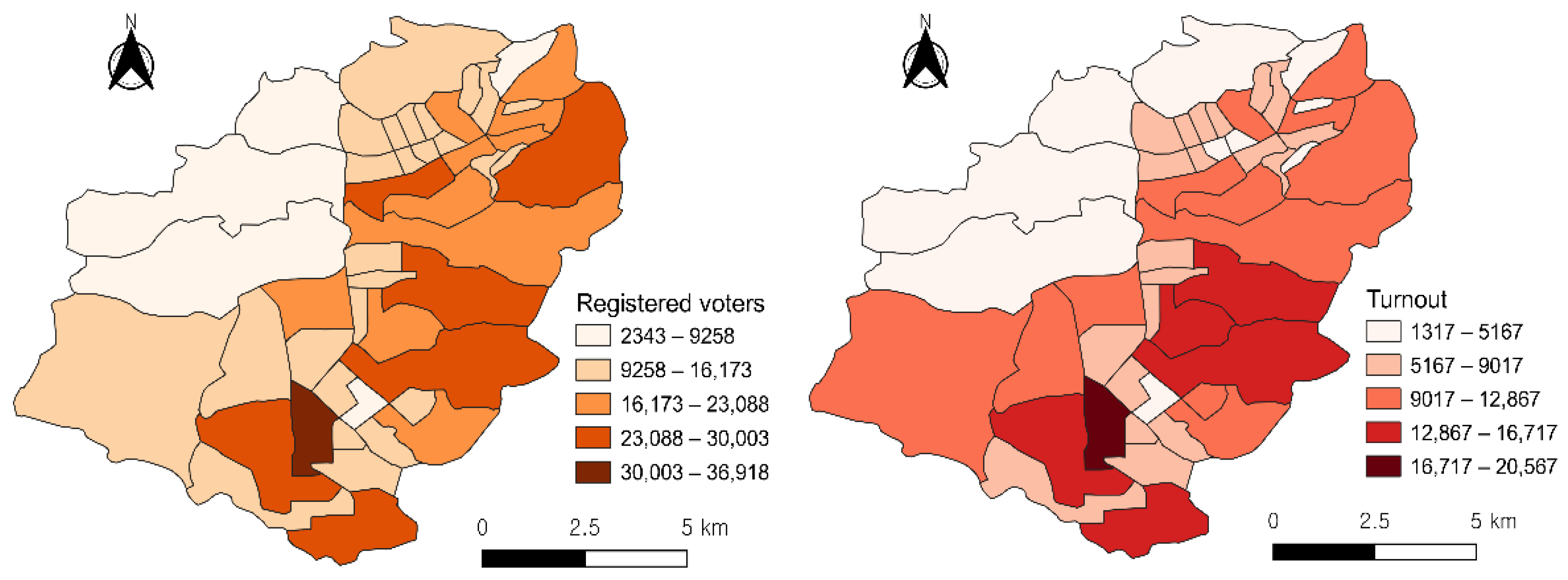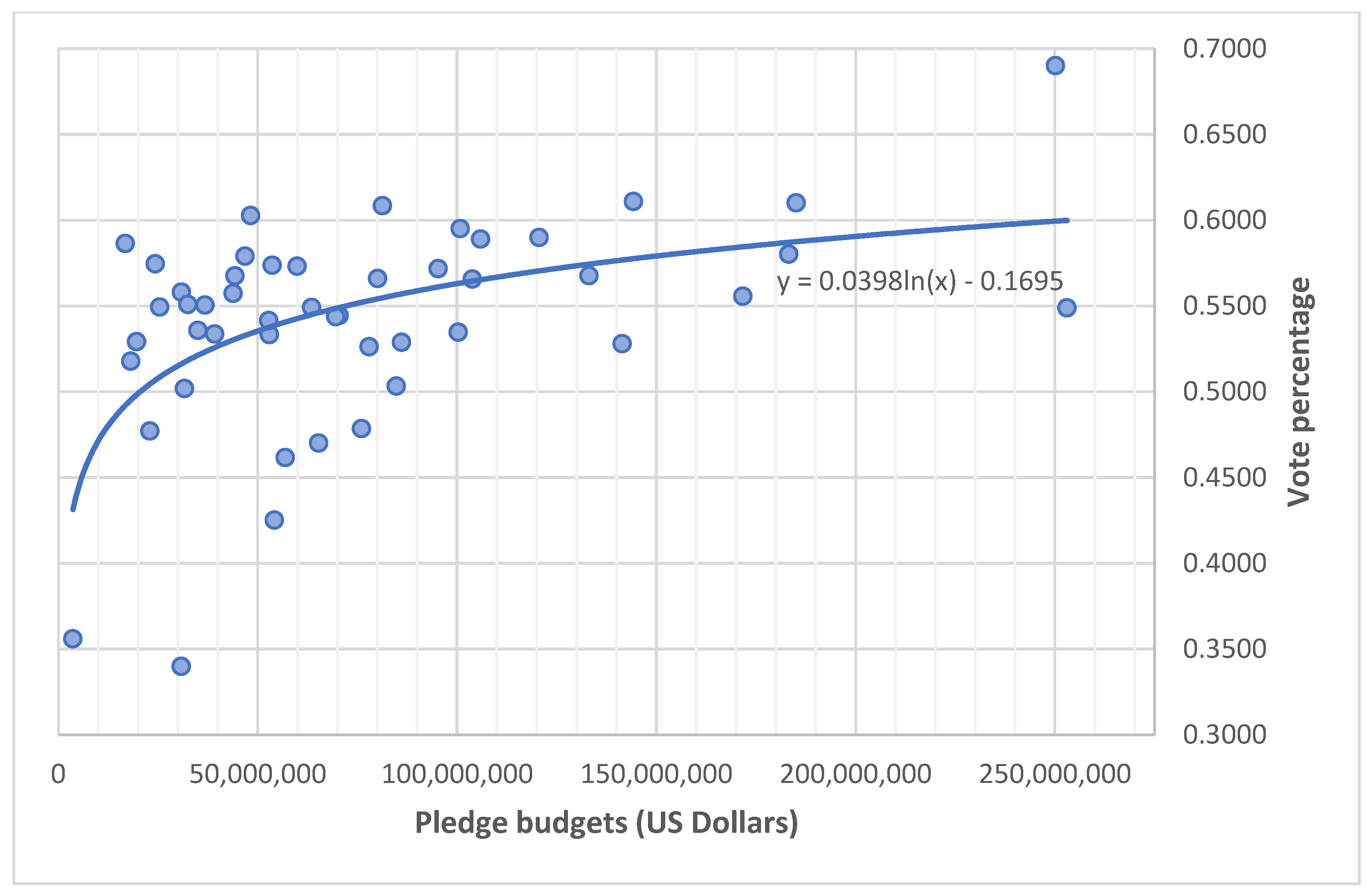The Influence of Urban Planning-Related Pledge Budget on Local Election Votes: A City Case in Korea
Abstract
:1. Introduction
2. Theoretical Background
3. Materials and Methods
3.1. Materials
3.1.1. Study Site
3.1.2. Data on Vote Percentage
3.1.3. Data on Urban Planning-Related Pledge Budget
3.2. Methods
4. Results and Discussion
4.1. Results
4.1.1. Estimating the Utility Value of Voting
- :
- The economic utility value of a vote exercised by an individual voter;
- :
- The expected utility of candidate A to win the election and fulfill promises to the voters by executing the urban planning-related pledge budget;
- :
- The expecting utility of candidate B to win the election and fulfill promises to the voters by executing the urban planning-related pledge budget;
- :
- Probability of implementing pledge budget;
- :
- Total number of voters.
4.1.2. Impact of Pledge Budget
4.1.3. Change in Slope of the Vote Percentage Curve by Budget Size
4.2. Discussion
5. Conclusions
Author Contributions
Funding
Acknowledgments
Conflicts of Interest
References
- Jeong, M.; Oh, S. Local Development Agenda and Symbolic Politics: Analysis of Manifestos by the Mayoral and Gubernatorial Candidates in the 2006 Local Elections. Korean Public Adm. Rev. 2008, 42, 217–238. (In Korean) [Google Scholar]
- Clingermayer, J.C.; Feiock, R.C. Institutional Constraints and Policy Choice: An Exploration of Local Governance; SUNY Press: Albany, NY, USA, 2014. [Google Scholar]
- Feiock, R.C.; Kim, J.-H. Form of government, administrative organization, and local economic development policy. J. Public Adm. Res. Theory 2001, 11, 29–50. [Google Scholar] [CrossRef]
- Kim, S.; Lee, H. New Approach of Regionalism based on Hometown-Residents and Non-Hometown Residents. Korean Political Sci. Rev. 2015, 49, 243–266. [Google Scholar]
- Kim, J. Party Competition in Local Elections: Focused on the Analysis of the Candidate’s Election pledges. J. Local Gov. Stud. 2012, 24, 113–135. (In Korean) [Google Scholar]
- Jung, S. Friends and Neighbors Voting in the 20th Korean National Assembly Election. J. Korean Politics 2017, 26, 129–157. [Google Scholar] [CrossRef]
- Kim, J.; Kim, J. The Cause for Strengthened Municipalities’ Statutory Power in the City Revitalization Context. Local Auton. Law Res. 2009, 9, 191–216. [Google Scholar]
- Han, A.T.; Laurian, L.; Dewald, J. Plans Versus Political Priorities: Lessons From Municipal Election Candidates’ Social Media Communications. J. Am. Plan. Assoc. 2020, 87, 1–17. [Google Scholar] [CrossRef]
- Terrill, M. Transport planning and election promises. Plan. News 2019, 45, 10. [Google Scholar]
- Scott, A.J.; Roweis, S.T. Urban planning in theory and practice: A reappraisal. Environ. Plan. A 1977, 9, 1097–1119. [Google Scholar] [CrossRef]
- Huh, M. Public Choice Model of Korean Local Governments. Financ. J. 1999, 13, 111–137. (In Korean) [Google Scholar]
- Holcombe, R.G. Public choice in a local government setting. Public Choice 2011, 149, 1. [Google Scholar] [CrossRef]
- Hwang, K. The Study of correlation analysis with winning the election and the difference analysis of the candidate’s transportation field promise in the local election of Jeju Island. J. Local Gov. Stud. 2002, 14, 219–236. (In Korean) [Google Scholar]
- Pak, S.; Yoo, Y. The Strategic Characteristics of Space Design Marketing in 6‧4 Local Elections-Focused on 6 Cities in Jeonlabuk-do. J. Reg. Assoc. Archit. Inst. Korea 2014, 16, 83–92. (In Korean) [Google Scholar]
- Born, A.; van Eck, P.; Johannesson, M. An experimental investigation of election promises. Political Psychol. 2018, 39, 685–705. [Google Scholar] [CrossRef]
- Matthieß, T. Retrospective pledge voting: A comparative study of the electoral consequences of government parties’ pledge fulfilment. Eur. J. Political Res. 2020, 59, 1–23. [Google Scholar] [CrossRef] [Green Version]
- Naurin, E.; Soroka, S.; Markwat, N. Asymmetric accountability: An experimental investigation of biases in evaluations of governments’ election pledges. Comp. Political Stud. 2019, 52, 2207–2234. [Google Scholar] [CrossRef]
- Webster, C.J. Public choice, Pigouvian and Coasian planning theory. Urban Stud. 1998, 35, 53–75. [Google Scholar] [CrossRef]
- Buchanan, J.M.; Tullock, G. The Calculus of Consent; University of Michigan Press Ann Arbor: Ann Arbor, MI, USA, 1962; Volume 3. [Google Scholar]
- Mueller, D.C. Public Choice III.; Cambridge University Press: Cambridge, MA, USA, 2003. [Google Scholar]
- Dollery, B.E.; Wallis, J.L. Market failure, government failure, leadership and public policy. J. Interdiscip. Econ. 1997, 8, 113–126. [Google Scholar] [CrossRef]
- Downs, A. An Economic Theory of Democracy; Harper: New York, NY, USA, 1957. [Google Scholar]
- Lee, J. Economic Voting in the 17th Presidential Election: Economic Perception and Voting Behavior. J. Contemp. Politics 2008, 1, 111–136. (In Korean) [Google Scholar]
- Kim, G. Costs of Voting in Rational Choice Theory: Costs of Participation, or Costs of Decision? Korean J. Soc. Sci. 2019, 38, 5–38. [Google Scholar] [CrossRef]
- Buchanan, J.M. Hegel on the Calculus of Voting. Public Choice (pre-1986) 1974, 17, 99. [Google Scholar] [CrossRef]
- Na, D.; Lee, R.; Nam, M.; Kim, J.; Kim, B. The Effect of Physical Education Promises on Electoral Competitiveness for the 18th General Election. Korean Soc. Sociol. Sport 2012, 25, 73–92. [Google Scholar]
- Cho, Y. Election Promises on Library Fields of the Candidates and Implementation of Their Promises of the Elected Heads of Daegu Metropolitan City in the 5th Local Electio. J. Korean Biblia Soc. Library Inf. Sci. 2013, 24, 153–180. [Google Scholar]
- Oh, S. A Study on the Effects of the Performance of Local Public Finance Operation on Local Re-election Voting. Korean Local Adm. Rev. 2012, 9, 121–141. (In Korean) [Google Scholar]
- Cho, H.; Lee, H.; Min, H. Candidates’ Campaign Strategies and Vote Shares in the 20th National Assembly Elections. J. Korean Politics 2016, 25, 57–87. [Google Scholar]
- Kang, J. A Study on the Manifesto of Local Government Leaders and 2010 Local Election. Korean Political Stud. 2013, 22, 53–80. (In Korean) [Google Scholar]
- Riker, W.H.; Ordeshook, P.C. A Theory of the Calculus of Voting. Am. Political Sci. Rev. 1968, 62, 25–42. [Google Scholar] [CrossRef]
- Lee, C. The Effect of Public Pledges on Actual Policy: The Case of Incheon City Government; Seoul National University: Seoul, Korea, 2012. (In Korean) [Google Scholar]
- Chun, S.; Lee, Y.; Choi, Y. How are Conservatives and Progressives Different in Processing Preference-inconsistent Information in Political Ads?: From the Perspective of the Heuristic-Systematic Model. Korean J. Advert. 2011, 22, 91–110. (In Korean) [Google Scholar]
- Cho, H.; Lew, S.; Jeon, S.; Park, J.; Lim, S. A Study on the Messaging and the PR Strategies of the Candidates for the 6th Local Election in Korea: Focus on the Features of the Election Leaflets. Korean Party Stud. Rev. 2014, 13, 123–156. [Google Scholar]
- Ansolabehere, S.; Rodden, J.; Snyder, J.M., Jr. The strength of issues: Using multiple measures to gauge preference stability, ideological constraint, and issue voting. Am. Political Sci. Rev. 2008, 102, 215–232. [Google Scholar] [CrossRef] [Green Version]
- Highton, B. The contextual causes of issue and party voting in American presidential elections. Political Behav. 2010, 32, 453–471. [Google Scholar] [CrossRef] [Green Version]
- Van der Eijk, C.; Van der Brug, W.; Kroh, M.; Franklin, M. Rethinking the dependent variable in voting behavior: On the measurement and analysis of electoral utilities. Elect. Stud. 2006, 25, 424–447. [Google Scholar] [CrossRef]
- Yun, S.; Joo, M. Explaining Voter Turnout in the 18th Korean General Election. Korean J. Econ. Stud. 2010, 58, 221–254. [Google Scholar]
- Cho, S. Politics of Electoral Participation: The Formal Model of Rational Choice Theory and the 17th KoreanNational Assembly Election. Korean Political Sci. Rev. 2006, 40, 51–74. (In Korean) [Google Scholar]
- Moon, W. Electoral Competitiveness and the Effect of Incumbent Spending: A Spatial Model Analysis. Korean Political Sci. Rev. 2005, 39, 125–144. [Google Scholar]
- Moon, W. Regional Voting and Rational Choice Theory: A Spatial Model Analysis. Korea World Politics 2005, 21, 151–186. (In Korean) [Google Scholar]
- Lee, S. 6·4 Local Election Pledge Analysis Resident-centered administration against populism. Mon. Public Policy 2014, 105, 64–66. (In Korean) [Google Scholar]
- Kim, J. The impact of Prospective Public Policy Evaluation, Candidate Quality Evaluation, and Feeling Thermometer toward United Nonpartisan Candidate, DooGwan Kim in 2010 Kyungnam Gubernatorial Voting Decisions: The 1st Kyungnam Gubernatorial Election Case Overcoming Regionalism. Korean J. Local Gov. Stud. 2014, 18, 503–527. (In Korean) [Google Scholar]
- Keefer, P.; Knack, S. Boondoggles, rent-seeking, and political checks and balances: Public investment under unaccountable governments. Rev. Econ. Stat. 2007, 89, 566–572. [Google Scholar] [CrossRef]
- De la Calle, L.; Orriols, L. Explaining the electoral effects of public investments: The case of the expansion of the underground in Madrid, 1995–2007. Eur. J. Political Res. 2010, 49, 393–417. [Google Scholar] [CrossRef]
- Hong, J.Y.; Park, S. Factories for votes? How authoritarian leaders gain popular support using targeted industrial policy. Br. J. Political Sci. 2016, 46, 501–527. [Google Scholar] [CrossRef]
- Cho, J.E.; Lee, J.S.; Song, B. Mind the Electoral Gap: The Effect of Investment in Public Infrastructure on Authoritarian Support in South Korea. Stud. Comp. Int. Dev. 2019, 54, 473–500. [Google Scholar] [CrossRef]
- Newman, P.W.; Newman, P.; Thornley, A. Urban. Planning in Europe: International Competition, National Systems, and Planning Projects; Psychology Press: London, UK, 1996. [Google Scholar]




| Dependent Variable | Independent Variable | Unstandardized Coefficients | Standardized Coefficients | t | Significance Level | Remarks | |
|---|---|---|---|---|---|---|---|
| B | Std. Error | Beta | |||||
| vote percentage | (constant) | 0.505 | 0.013 | 37.886 | 0.000 | R2 = 0.211 adj. R2 = 0.194 F = 12.303 ** **: p < 0.01 | |
| budget | 4.225 × 10−7 | 0.000 | 0.459 | 3.508 | 0.001 | ||
| competition for votes | (constant) | 0.018 | 0.027 | 0.660 | 0.513 | R2 = 0.212 adj. R2 = 0.194 F = 12.345 ** **: p < 0.01 | |
| budget | 8.535 × 10−7 | 0.000 | 0.460 | 3.514 | 0.001 | ||
Publisher’s Note: MDPI stays neutral with regard to jurisdictional claims in published maps and institutional affiliations. |
© 2020 by the authors. Licensee MDPI, Basel, Switzerland. This article is an open access article distributed under the terms and conditions of the Creative Commons Attribution (CC BY) license (http://creativecommons.org/licenses/by/4.0/).
Share and Cite
Kim, S.; Jung, C. The Influence of Urban Planning-Related Pledge Budget on Local Election Votes: A City Case in Korea. Land 2020, 9, 493. https://doi.org/10.3390/land9120493
Kim S, Jung C. The Influence of Urban Planning-Related Pledge Budget on Local Election Votes: A City Case in Korea. Land. 2020; 9(12):493. https://doi.org/10.3390/land9120493
Chicago/Turabian StyleKim, Sungjun, and Changmu Jung. 2020. "The Influence of Urban Planning-Related Pledge Budget on Local Election Votes: A City Case in Korea" Land 9, no. 12: 493. https://doi.org/10.3390/land9120493
APA StyleKim, S., & Jung, C. (2020). The Influence of Urban Planning-Related Pledge Budget on Local Election Votes: A City Case in Korea. Land, 9(12), 493. https://doi.org/10.3390/land9120493





